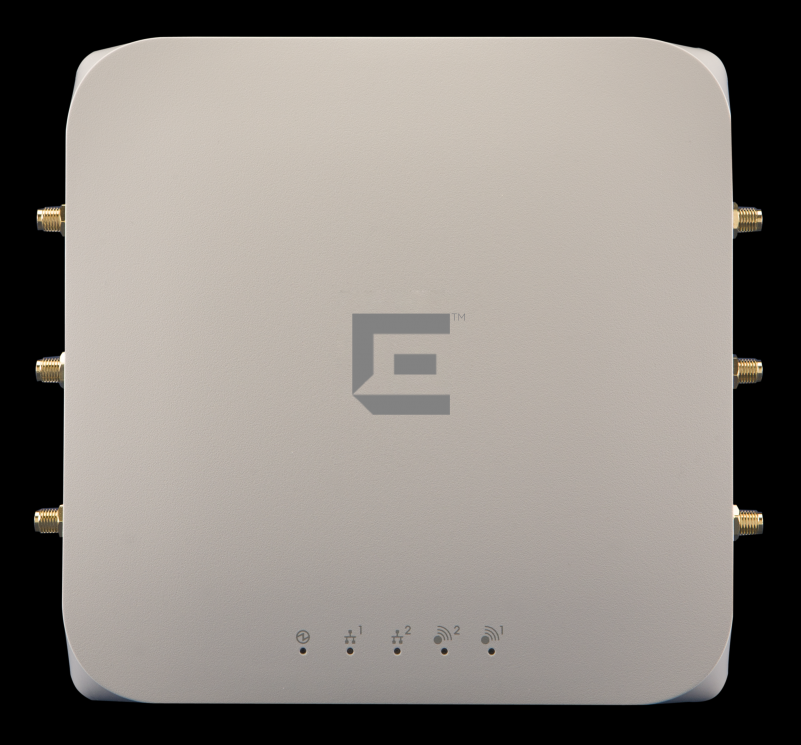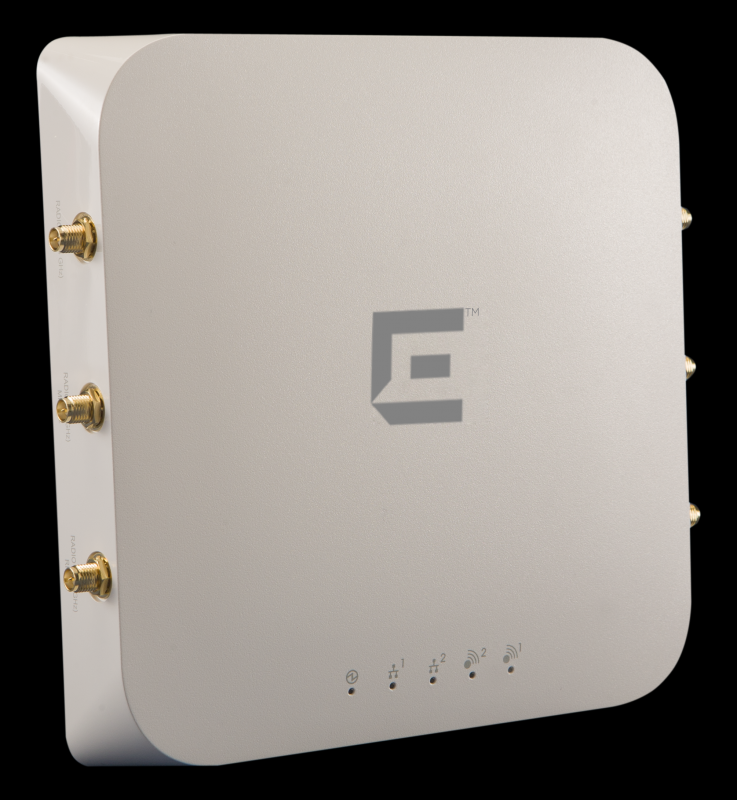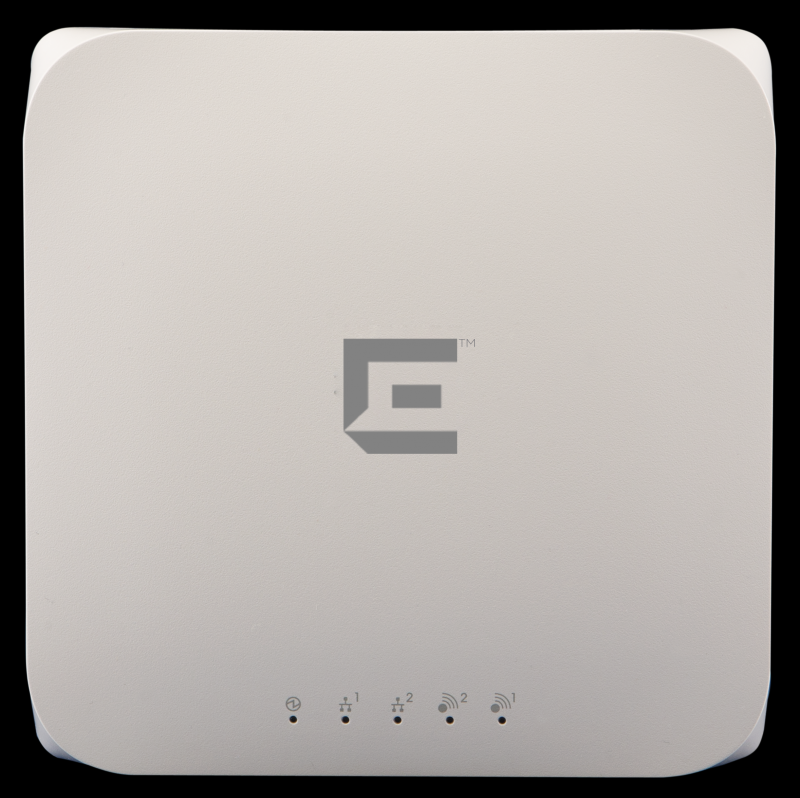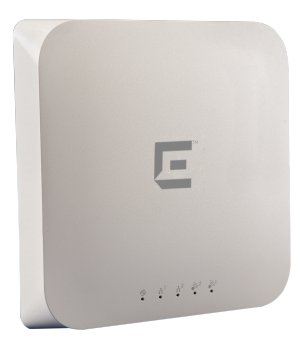Extreme Networks Extreme Wireless AP 3825
Purpose built for the mobile user experience
High- performance, enterprise-grade for mission critical deployments.
The AP3825 is a high-performance 802.11ac and 802.11abgn indoor access point purpose built for high-density deployments. This access point is designed to operate in heavy-user and mission critical environments such as healthcare facilities, universities, conference centers, arenas, and stadiums. Active/active data ports and multiple power options ensure that the AP3825 provides always-on connectivity for data, high-bandwidth video applications and low-latency voice applications.
Unique to this class of access point, the power efficient AP3825 uses 802.3af Power over Ethernet (PoE) without reducing its performance or degrading its enterprise-grade capabilities. This means that an upgrade to more expensive switches for support of the higher PoE 802.3at standard is not required thereby providing investment protection for existing switch infrastructure.
| High performance enterprise class AP | √ |
| Number of radios | 2 |
| MIMO implementation for high performance 11ac & 11n throughputs |
3×3 |
| Number of spatial streams | 3 |
| Maximum Throughput 2.4GHz Radio | 450Mbps |
| Maximum Throughput 5GHz Radio | 1.3Gbps |
| Maximum Throughput per AP | 1.75Gbps |
| RFC2285 Wire/Wireless Forwarding Rate | 75,000 packets per second |
| Number of SSIDs supported per radio / total | 8 / 16 |
| Simultaneous users per AP | 316 |
| Simultaneous Voice calls (802.11b, G711, R>80) | 12 or greater |
| Mode of operation | Semi-autonomous |
| Plug and play operation/Zero touch deployment | √ |
| Security and Standards | WPA, WPA2 (AES), 802.11i, 802.1x, IPSec, IKEv2, PKCS #10, X509 DER / PKCS #12PKCS #10, X509 DER / PKCS #12 |
-
Maximum Throughput
5GHz Radio 1.3Gbps
-
Maximum Throughput
5GHz Radio 1.3Gbps
-
Number of radios
2
-
High performance enterprise class AP
Yes
-
Maximum Throughput
2.4GHz Radio 450Mbps
-
Maximum Throughput
per AP 1.75Gbps
-
MIMO implementation for high performance
MIMO implementation for high performance 11ac & 11n throughputs 3×3
-
Mode of operation
Semi-autonomous
-
Number of spatial streams
3
-
Number of SSIDs supported per radio
total 8 / 16
-
Plug and play operation/Zero touch deployment
Yes
-
RFC2285 Wire/Wireless Forwarding Rate
75,000 packets per second
-
Security and Standards
WPA, WPA2 (AES), 802.11i, 802.1x, IPSec, IKEv2, PKCS #10, X509 DER / PKCS #12PKCS #10, X509 DER / PKCS #12
-
Simultaneous users per AP
316
-
Simultaneous Voice calls
(802.11b, G711, R>80) 12 or greater
| High performance enterprise class AP | √ |
| Number of radios | 2 |
| MIMO implementation for high performance 11ac & 11n throughputs |
3×3 |
| Number of spatial streams | 3 |
| Maximum Throughput 2.4GHz Radio | 450Mbps |
| Maximum Throughput 5GHz Radio | 1.3Gbps |
| Maximum Throughput per AP | 1.75Gbps |
| RFC2285 Wire/Wireless Forwarding Rate | 75,000 packets per second |
| Number of SSIDs supported per radio / total | 8 / 16 |
| Simultaneous users per AP | 316 |
| Simultaneous Voice calls (802.11b, G711, R>80) | 12 or greater |
| Mode of operation | Semi-autonomous |
| Plug and play operation/Zero touch deployment | √ |
| Security and Standards | WPA, WPA2 (AES), 802.11i, 802.1x, IPSec, IKEv2, PKCS #10, X509 DER / PKCS #12PKCS #10, X509 DER / PKCS #12 |
| Intelligent thin AP | Encryption, Security, QoS and RF management done on AP |
| Distributed and centralized data paths within same SSID |
√ |
| Application based distributed and centralized data paths within same user/device session |
√ |
| Simultaneous RF monitoring and client services | √ |
| In-channel WIDS | √ |
| In-channel WIPS | √ |
| Dedicated multi-channel WIDS (Guardian mode) | 9.01.02 |
| Dedicated multi-channel WIPS (Guardian mode) | 9.01.02 |
| Dedicated multi-channel RF spectrum analysis and fingerprinting |
9.01.02 |
| Locates devices and threats via RF triangulation | √ |
| Self-forming and self-healing meshing | √ |
| Remote access point | √ |
| Hardware-based, end-to-end data and control plane encryption |
√ |
| Private and public cloud deployments | √ |
| Security scanning and serve clients on same radio | √ |
| Security scanning and spectrum analysis on same radio |
√ |
| Spectrum analysis and serve clients on same radio |
√ |
| Multi-channel dedicated security scanning and spectrum analysis |
9.01.02 |
| Radio 1 (5GHz) | 26 dBm |
| Radio 2 (2.4GHz) | 26 dBm |
| Radio 1 (5GHz) | 6 dBi (AP3825i) |
| Radio 2 (2.4GHz) | 4 dBi (AP3825i) |
| Dynamic Channel Control | 802.11h: DFS & TPC support (ETSI) |
| Efficient use of the spectrum with a multi-channel architecture | √ |
| Automatic transmit power and channel control | √ |
| Self-healing with coverage gap detection | √ |
| Band steering with multiple steering modes | √ |
| Spectrum load balancing of clients | √ |
| Airtime fairness | √ |
| Performance protection in congested RF environments | √ |
| Mitigates co-channel interference with coordinated access | √ |
| Mitigates adjacent channel interference with optimized receive sensitivity | √ |
| Efficient reuse of channels at shorter intervals | √ |
| Mitigates non 802.11 interference without dedicated radios | √ |
| Support for Protection Management Frame 802.11w | √ |
| Radio Resource Management (support for 802.11k) | √ |
| Quality of Service (WMM, 802.11e) | √ |
| Power Save (U-APSD) | √ |
| Fast secure roaming and handover between APs | √ |
| Pre-Authentication (Pre-Auth) | √ |
| Opportunistic Key Caching (OKC) | √ |
| Bonjour/LLMNR/UPnP identification, containment and control | √ |
| Supports voice, video, and data using the same SSID | √ |
| Prioritizes voice over data for both tagged and untagged traffic | √ |
| Rate limiting (rule and user-based) | √ |
| Rule and role based QoS processing | √ |
| Multicast to unicast Conversion | √ |
| Adaptable rate multicast | √ |
| Power save mode optimization for multicast | √ |
| Media Access Protocol | CSMA/CA with ACK |
| Data Rates | 802.11a: 6, 9, 12, 18, 24, 36, 48, 54 Mbps 802.11b: 1, 2, 5.5, 11 Mbps 802.11g: 1, 2, 5.5, 6, 9, 11, 12, 18, 24, 36, 48, 54 Mbps 802.11n: See 802.11n Performance Table below 802.11ac: See 802.11ac Performance Table below Receiver Sensitivity 802.11a: • -92dBm @ 6Mbps • -76dBm @ 54Mbps 802.11g: • -92dBm @ 6Mbps • -76dBm @ 54Mbps 802.11b: • -93dBm @ 1Mbps • -90dBm @ 11Mbps 802.11n: See 802.11n Receiver Sensitivity Table below 802.11ac: See 802.11ac Receiver Sensitivity Table below |
| Frequency Bands | 802.11ac/a/n: • 5.15 to 5.25 GHz (FCC/IC/ ETSI) • 5.25 to 5.35 GHz (FCC/IC/ETSI)* • 5.47 to 5.725 GHz (FCC/IC/ETSI)* • 5.725 to 5.850 GHz (FCC/IC) 802.11b/g/n: • 2.400 to 2.4720 GHz (FCC/IC) • 2.400 to 2.4835 GHz (ETSI) *FCC/IC DFS certification in progress |
| Wireless Modulation | 802.11ac: BPSK, QPSK, 16QAM, 64QAM, 256QAM with OFDM 802.11ac Packet aggregation: A-MPDU, A-MSDU 802.11ac Very High-Throughput (VHT): VHT20/40/80 802.11ac Advanced Features: LDPC, STBC, Maximum Likelihood (ML) Detection 802.11n: BPSK, QPSK, 16QAM, 64QAM with OFDM 802.11n High-throughput (HT) support: HT 20/40 802.11n Packet aggregation: A-MPDU, A-MSDU 802.11n Advanced Features: LDPC, STBC and TxBF 802.11a: BPSK, QPSK, 16QAM, 64QAM with OFDM 802.11g: DSSS and OFDM 802.11b: DSSS |
| # 10/100/1000 Base T Ethernet autosensing link | 2 |
| Active/active and active/passive with dynamic LAG support (LACP) | √ |
| Console port for the ease of installation and management | √ |
| Wall mounting | √ |
| Drop-ceiling mounting bracket (15/16” included, 9/16” optional) | √ |
| Environmental | Plenum rated (UL 2043) Operating: Temperature 0° C to +50° C (+32° F to +122° F) Humidity 0%-95% (noncondensing) Storage: Temperature -5° C to +50° C (+23° F to +122° F) Transportation: Temperature -40° C to +70° C (-40° F to +158° F) |
| Compliance | •FCC CFR 47 Part 15, Class B •ICES-003 Class B •FCC Subpart C 15.247 •FCC Subpart E 15.407 •RSS-210 •EN 301 893 •EN 300 328 •EN 301 489 1 and 17 •EN 62311 •EN 55022 (CISPR 22) •EN 60601-1-2 •AS/NZS4268 + CISPR22 |
| Safety | •IEC 60950-1 •EN 60950-1 •UL 60950-1 •CSA 22.2 No.60950-1-03 •AS/NZS 60950.1 |
| Mechanical | 6.56” x 1.34” x 6.56” (AP3825i) |
| Dimensions (W x H x L) | 7.12” x 1.34” x 6.56” (AP3825e) |
| Weight | 1.35lbs (0.6 kg) |
| Max power consumption | 12.95W |
| Warranty | Lifetime |




